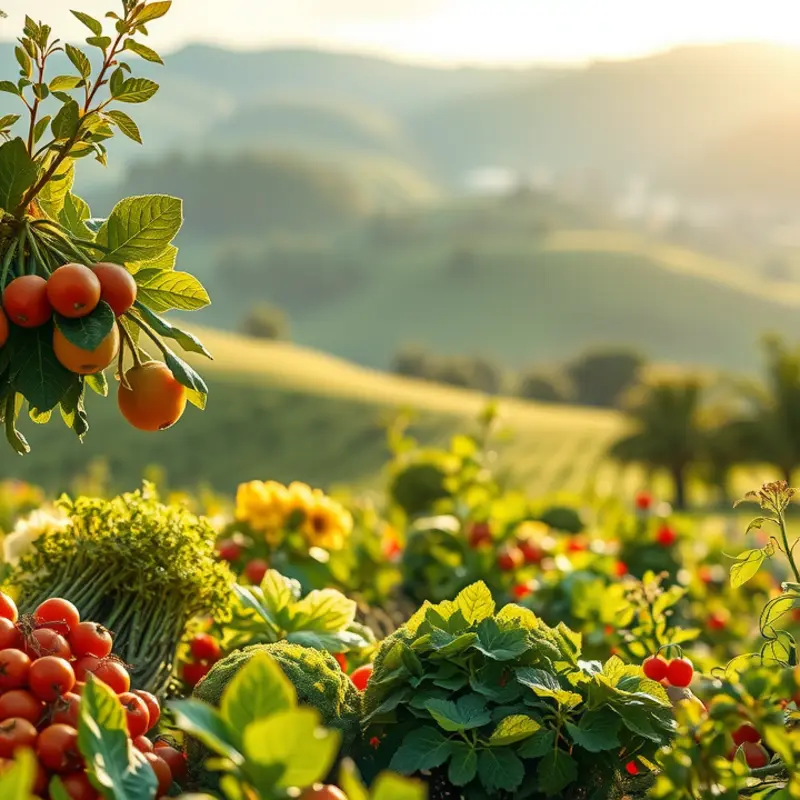Water is the vital lifeblood of our planet, yet its scarcity is an increasing concern. Each food decision we make significantly affects water consumption and availability. Emphasizing water conservation through informed food choices not only enhances individual awareness but also fosters a collective responsibility towards our environment. Let’s explore practical ways to align your diet with sustainable practices, ensuring that both your meals and our planet thrive.
Maximizing Impact: Choosing Water-Efficient Foods

When we think about water conservation, turning off taps and fixing leaks are common first thoughts. However, our plates hold a surprising key to preserving this vital resource. Choosing water-efficient foods can significantly reduce your dietary water footprint, illustrating how individual choices accumulate into substantial environmental benefits.
Plant-Based Options: A Thirst for Efficiency
Diets rich in plant-based foods tend to consume less water compared to those centered around animal products. For instance, producing a kilogram of beef requires over 15,000 liters of water, whereas a simple kilogram of potatoes uses approximately 290 liters. Transitioning to a plant-based diet reduces water usage drastically, as legumes, grains, and vegetables generally have a smaller water footprint. Emphasizing legumes like lentils and beans in your meals not only aids water conservation but also provides rich protein sources.
Seasonal Produce: Syncing with the Natural Calendar
Consuming seasonal produce aligns your diet with the natural growth cycles of plants, minimizing dependence on artificial irrigation. For example, enjoying strawberries in summer, when they naturally thrive, limits the need for water-intensive practices required to grow them out of season. Eating seasonally ensures that food production utilizes rainwater more efficiently, reducing the reliance on supplemental water sources. Explore local farmers’ markets to find fresh, in-season produce, thereby supporting water-wise agriculture while enjoying peak flavors.
Local Sourcing: Reducing Water-Related Transport Costs
Opting for locally-sourced foods further curtails water usage, indirectly conserving resources by reducing the need for transportation and packaging. Imported goods often require a complex web of logistics, consuming significant amounts of water in the process. By selecting ingredients from nearby sources, you’re supporting regional farmers and reducing the water footprint associated with long-distance transportation. For tips on eco-smart kitchen storage, you can explore this link.
Comparative Insights: Measuring Water Impact
Understanding the water consumption of different food categories can guide more conscious meal planning. To illustrate, almonds and other nuts, though plant-based, are relatively water-intensive due to farming conditions. Conversely, grains such as oats and barley are more water-efficient and versatile, fitting seamlessly into a variety of meals. By comparing the water footprints of foods, you can prioritize choices that are less taxing on water supplies.
Adopting a mindful approach to food selection enriches your diet and promotes sustainability. By emphasizing water-efficient foods like plant-based options, seasonal produce, and locally-sourced ingredients, you contribute to the preservation of our planet’s water reservoirs. With each meal, you’re empowered to make a difference, demonstrating that conscientious food choices can lead to substantial water conservation.
Plant Power: The Benefits of Choosing a Plant-Based Diet

Adopting a plant-based diet plays a crucial role in water conservation, significantly reducing the water footprint compared to a meat-based diet. Raising livestock is notoriously water-intensive, with thousands of liters required for a single kilogram of beef or pork. In contrast, plant foods like legumes, grains, and vegetables demand considerably less water, offering a sustainable alternative.
Legumes, such as lentils and chickpeas, serve as excellent sources of protein and fiber. They require minimal irrigation compared to meat production. For instance, producing a kilogram of lentils uses roughly 1,250 liters of water, while the same amount of beef needs about 15,000 liters. This significant difference emphasizes why legumes are both a nutritious and environmentally responsible choice.
Grains like quinoa, rice, and oats also contribute to water savings. While rice is relatively water-intensive among grains, innovations in farming practices are improving its sustainability. Quinoa and oats, on the other hand, are excellent candidates for water conservation. They thrive in diverse environments and need substantially less water than meat production, promoting a balanced and sustainable diet.
Vegetables are another vital component of a plant-based diet, offering essential nutrients with a low water cost. Leafy greens, tomatoes, and root vegetables like carrots and potatoes require proportionally less water compared to animal-derived foods. Diversifying your diet with a wide array of vegetables not only benefits health but also aids water conservation efforts.
Transitioning to a plant-based diet doesn’t mean sacrificing flavor or satisfaction. Incorporating bold spices, diverse cooking techniques, and plant-based proteins can create satisfying meals. Exploring global cuisines can significantly enrich a plant-based diet. For practical ingredient suggestions, resources like easy plant-based eating offer guidance on flavorful transitions.
Start by integrating more plant-based meals into your routine. Meatless Mondays, for example, can be an easy entry point. Over time, increasing the frequency of plant-based meals can ease the transition. Experiment with new plant-based recipes, such as vegetable stir-fries, grain bowls, or legume-based stews.
By choosing a plant-based diet, you make a significant impact on saving one of our planet’s most precious resources: water. Each plant-based meal contributes to reducing demand for water-intensive livestock, supporting both personal and environmental health.
Final words
The choices we make at the table have the power to impact the environment, particularly in water conservation. By prioritizing food options that are water-efficient and embracing a more plant-based diet, every individual can contribute to safeguarding this essential resource. These simple yet profound shifts in dietary habits create ripples of change, fostering a more sustainable and resilient planet. Each meal becomes an opportunity to nurture both personal health and environmental wellbeing.








